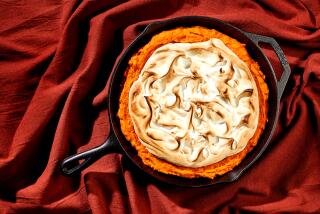No Sugar for the Sweets
- Share via
My friend Lois has the right idea: when in doubt, sweet potatoes. Simply roasted in the skins, they appear on her table throughout the winter with a frequency that suggests old-time Southern roots, though she was born in New Jersey. The leftovers are eaten cold, diced into chicken soup, added at the last minute to stir-fries or hashed brown with onions in a bit of olive oil.
What they are not is sweetened further, unless we’re making pie. There’s something about a sweet potato--can sugar be a magnet for its own kind?--that makes people want to season it with more of the same: from maple syrup to marshmallows, the list of dessert-oriented adjuncts is huge. The extra sugar is unnecessary and largely to blame, in my opinion, for the gross underutilization of this delicious and healthful vegetable--think of all that Vitamin A. It’s also an excellent source of Vitamin C.
Though their distinctive flavor and low starch content make them somewhat less versatile then white potatoes, sweet potatoes need not be confined to the plain-baked routine. They’re delicious steamed or braised with broth and are equally good, if more fattening, when sauteed in butter or bacon fat. Deep-frying is tricky, since only the starchiest types get crisp, but there is no more splendid potato chip than a sweet one.
*
Sweet potatoes take well to strong, aromatic herbs such as cilantro, rosemary and thyme, and they are nicely complemented by white wine, cider, lemon and orange juice. Partnership with smoked pork is traditional for good reason, and sweet potatoes are excellent foils for other assertive flavors: hot peppers, aged Cheddar cheese, garlic, balsamic vinegar. All these work in contrast to the sugar, making the finished product taste much livelier than the one-note preparations that simply repeat the sweet.
SELECTION AND STORAGE
Dozens of varieties of sweet potato are grown. The skins may be yellow, tan or magenta-brown, and the flesh color varies from just off-white to an orange so deep it’s almost red. By the time they get to the market, however, their identities have been merged into two broad categories: the Puerto Rico, which is orange-fleshed, very sweet, dense and moist, and the New Jersey, which is paler, starchier and considerably less sugary.
Puerto Ricos are often called yams, although they aren’t any such thing. More importantly, they aren’t potatoes, either. All sweet potatoes are part of the Ipomoea family, cousins to the morning glory. Yams (members of the genus Dioscorea ) are gigantic tropical tubers seldom seen in U. S. markets; and true potatoes, of course, are part of still another family, the huge Solanum group, relatives of tomatoes, peppers and eggplant. White potatoes and sweet potatoes are both underground tubers, but that’s about all they have in common.
Sweet potato tubers come in different shapes, from round to torpedo-like to very long and thin, with torpedoes by far the most commonly sold. Size does not affect flavor, though very large sweets may be somewhat woody, and very thin ones have a large proportion of skin to flesh. Choose sweet potatoes of even thickness to ensure even cooking, and look them over carefully to be sure there are no bruises, soft spots or mold.
Unlike white potatoes, sweets have a very high moisture content and do not store well. Keep them in a dry place, out of strong light, ideally at about 55 degrees. Higher temperatures shorten storage life; so, regrettably, does refrigeration. Buy sweet potatoes as you need them and use them as soon as possible. Do not store in plastic food bags, which trap moisture and hasten spoilage.
*
This festive winter side dish is a real candy-colored tangerine flake baby, swirls of deep magenta on a bright-orange background. Eye-catching, to say the least, and just as tasty as it is visually arresting. Practical, too; the whole thing can be prepared several hours in advance and simply heated at dinner time.
BEETS AND SWEETS
2 large or 3 medium beets, about 1 1/4 pounds
3 large Puerto Rico-type sweet potatoes, about 2 pounds
2 tablespoons butter, at room temperature, plus butter for pan
Zest 1 small orange, about 1 tablespoon grated
1 (1 1/2x1/2-inch) piece peeled fresh ginger, about 1 heaping tablespoon grated
1 large clove garlic
1/2 teaspoon salt
Scrub beets but do not trim off straggly roots. Place beets in shallow pan and bake at 375 degrees 30 minutes. Add sweet potatoes and bake 1 hour longer, or until all vegetables are very tender when pierced with knifepoint. Remove from oven and let cool until comfortable to handle. (Cooking may be done 1 day in advance.)
Put 2 tablespoons butter in bowl of food processor fitted with metal blade. Position grater over bowl and grate in orange zest, using 1/8-inch holes to get shreds instead of crumbles. Using same holes, grate in ginger, then garlic.
Peel cooled sweet potatoes, cut into chunks and add to processor with salt. Process just long enough to puree potatoes and incorporate seasonings.
Spread sweet potato puree in buttered shallow 1-quart casserole or gratin pan. Peel cooled beets, cut into chunks and process in unwashed processor bowl until beets are finely chopped.
Spread beets over sweet potatoes, then fold and swirl with spatula to streak colors. Do not overmix (only few strokes needed to get effect).
Cover pan with foil and bake at 350 degrees until heated through, 20 to 35 minutes. Makes 4 to 6 servings.


